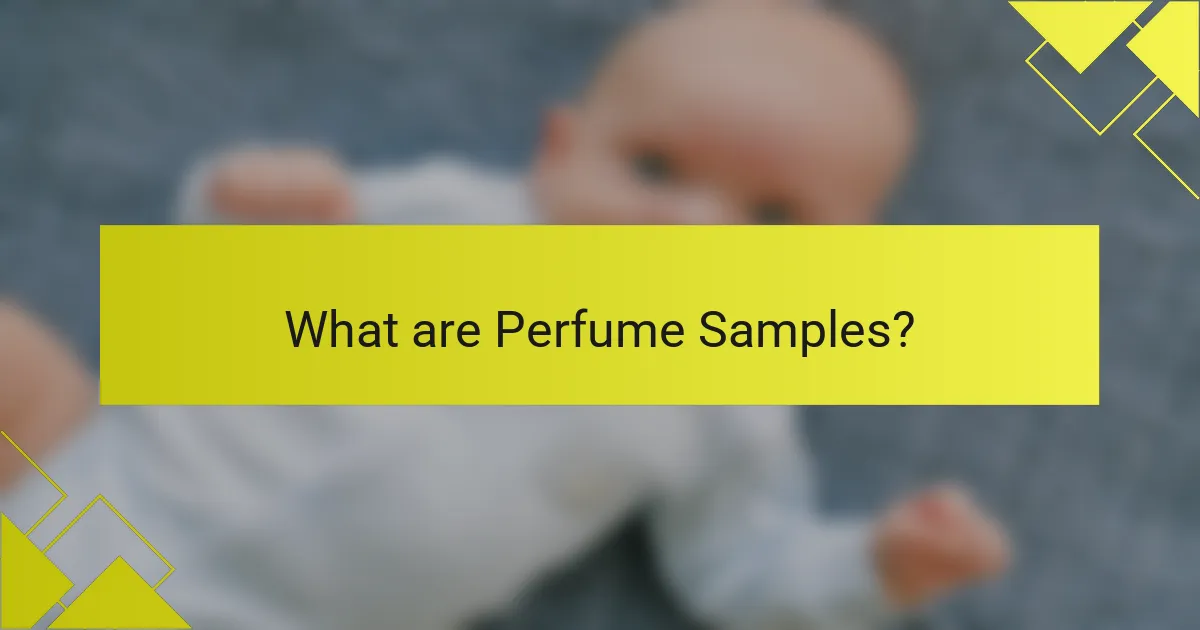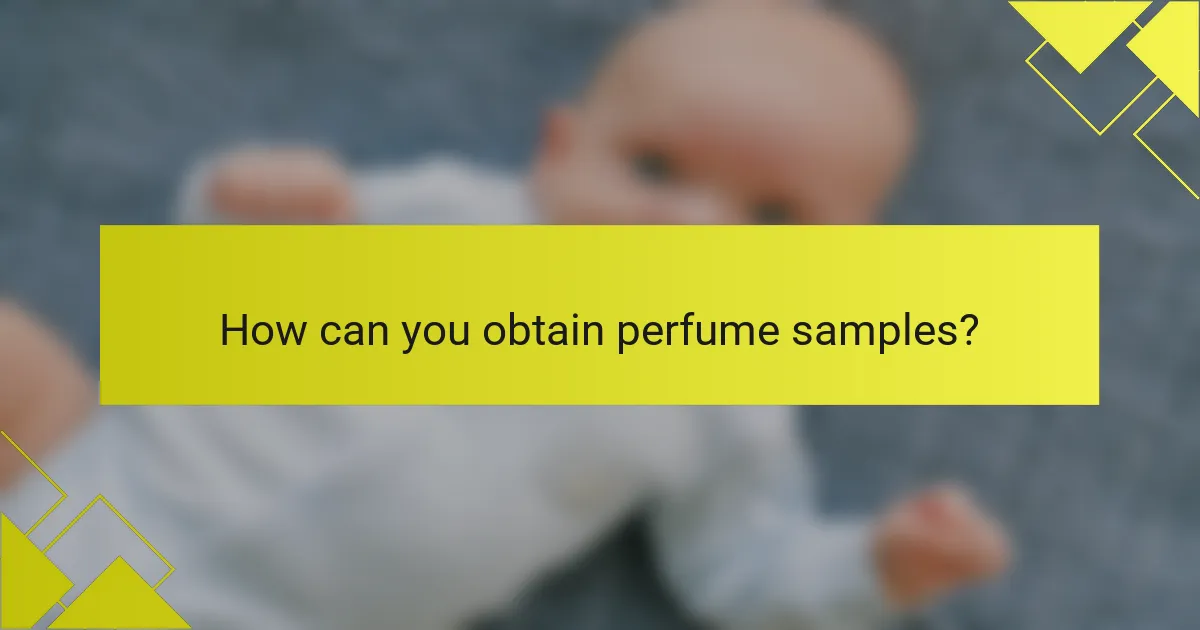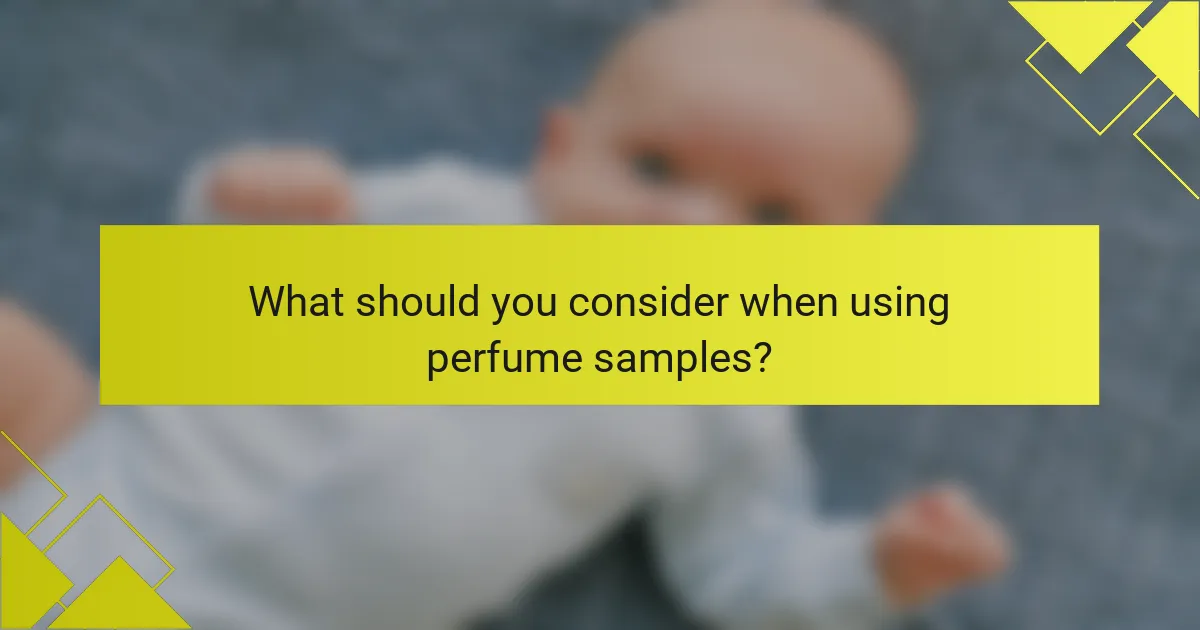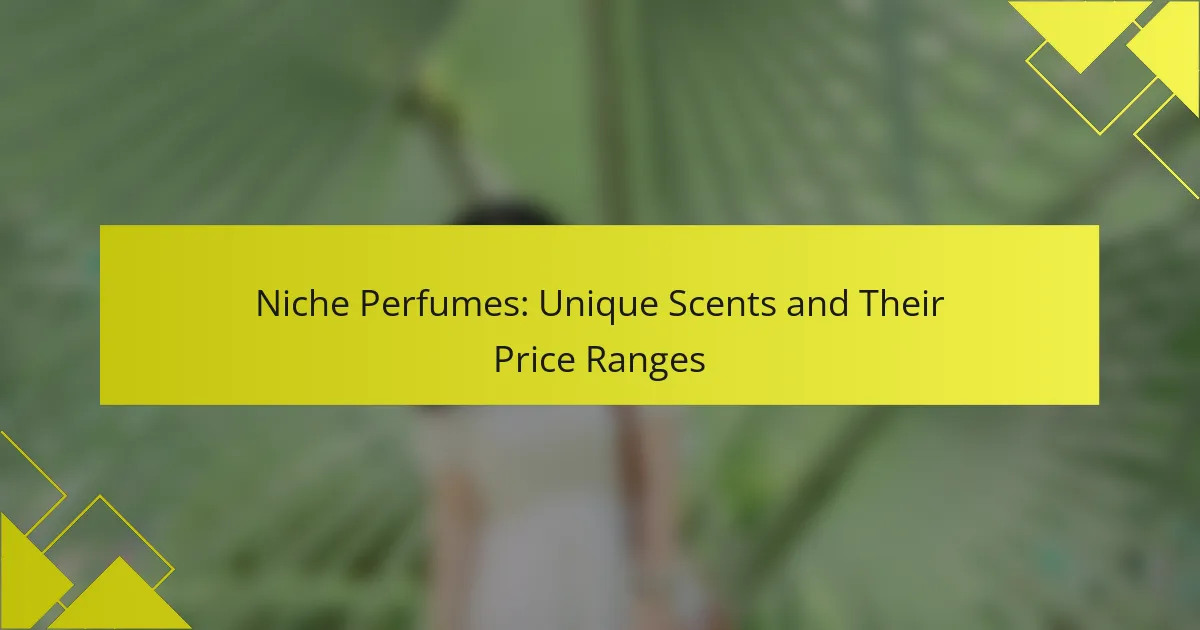
What are Perfume Samples?
Perfume samples are small vials of fragrance offered by brands or retailers. They allow consumers to test scents before purchasing full-sized bottles. Typically, these samples contain a few milliliters of perfume. They provide an economical way to explore different fragrances. Many brands include samples with online orders or as part of promotional events. Perfume samples help consumers make informed decisions about their fragrance choices. This practice is common in the beauty industry and enhances customer satisfaction.
How do perfume samples differ from full-sized fragrances?
Perfume samples differ from full-sized fragrances primarily in size and cost. Samples typically contain a small amount of fragrance, usually ranging from 1 to 5 milliliters. In contrast, full-sized fragrances generally come in bottles of 30 milliliters or more. This size difference makes samples a more affordable option for testing scents.
Samples allow consumers to experience a fragrance without committing to a full-sized purchase. Full-sized bottles often cost significantly more, sometimes exceeding $100. Perfume samples provide a risk-free way to explore different scents.
Additionally, samples may come in various forms, such as vials or spray applicators. Full-sized fragrances usually feature more elaborate packaging, including decorative bottles. This distinction in presentation can also influence consumer perception and choice.
What are the common sizes of perfume samples available?
Common sizes of perfume samples are typically 1 ml, 2 ml, and 5 ml. These sizes are widely used in the fragrance industry. A 1 ml sample is often sufficient for a few applications. The 2 ml size provides a bit more product for testing. The 5 ml sample is larger and offers a more extended exploration of the fragrance. Many brands offer these sizes in their sample sets. This standardization helps consumers try various scents without committing to full bottles.
Why are perfume samples important for fragrance exploration?
Perfume samples are important for fragrance exploration because they allow consumers to test scents before committing to a full bottle. Sampling provides an opportunity to experience the fragrance on the skin, where it interacts with body chemistry. This interaction can significantly alter how a scent smells compared to its initial impression in the bottle. Additionally, samples help consumers discover new fragrances that they might not have considered. According to a survey by Fragrantica, 70% of fragrance buyers prefer to sample before purchasing. This statistic highlights the value of samples in making informed decisions. Ultimately, perfume samples enhance the exploration process and reduce the risk of purchasing fragrances that may not suit individual preferences.
What benefits do perfume samples offer to consumers?
Perfume samples offer consumers the opportunity to explore different fragrances without committing to a full-sized bottle. They allow for testing scents on the skin, which is crucial as fragrances can change based on body chemistry. Samples are typically more affordable than full bottles, making them a cost-effective option. They also enable consumers to try multiple fragrances, helping them find their preferred scent. According to a survey by Fragrance Foundation, 70% of consumers prefer trying samples before purchasing. This practice reduces the risk of buyer’s remorse associated with fragrance purchases. Additionally, samples often come in travel-friendly sizes, making them convenient for on-the-go use.
How can perfume samples save money on fragrance purchases?
Perfume samples save money on fragrance purchases by allowing consumers to try scents before committing to full-sized bottles. This reduces the risk of buying fragrances that may not suit personal preferences. Many retailers offer free samples with purchases or as part of promotional events. According to a survey by Fragrance Foundation, 70% of consumers prefer sampling before buying. This practice helps avoid costly mistakes associated with blind purchases. Additionally, sampling can lead to discovering new favorites without the financial burden of full-size products. Overall, using perfume samples is a smart strategy to make informed fragrance choices while saving money.
What role do perfume samples play in discovering new scents?
Perfume samples play a crucial role in discovering new scents. They allow consumers to experience fragrances without committing to full-sized bottles. This makes them a cost-effective option for exploring various scent profiles. Perfume samples typically include small vials or strips that showcase a brand’s offerings. Users can test these samples on their skin to see how the scent evolves over time. This process helps individuals identify personal preferences and suitable fragrances. Research shows that sampling can increase customer satisfaction and reduce purchase regret. Overall, perfume samples facilitate informed decisions in fragrance selection.

How can you obtain perfume samples?
You can obtain perfume samples through various methods. Many fragrance retailers offer free samples with purchases. Online stores often provide sample options when ordering. You can also visit department stores and request samples from beauty consultants. Some brands have sample programs on their websites. Additionally, beauty subscription boxes frequently include perfume samples. Signing up for newsletters may also yield exclusive sample offers. These methods allow you to explore fragrances without significant investment.
What are the most common methods to acquire perfume samples?
The most common methods to acquire perfume samples include visiting retail stores, requesting samples online, and participating in promotional events. Retail stores often provide testers or samples upon request. Many fragrance brands have websites where customers can sign up for free samples. Additionally, beauty subscription boxes frequently include perfume samples as part of their offerings. These methods allow consumers to explore different fragrances without purchasing full-sized bottles.
How do online retailers provide samples with purchases?
Online retailers provide samples with purchases by including them in the order shipment. Many retailers offer a selection of sample sizes for customers to choose from. These samples are often inserted into the packaging alongside the purchased items. Retailers may also allow customers to select specific samples during the checkout process. This strategy enhances customer experience and encourages future purchases. According to a survey by the National Retail Federation, 67% of consumers appreciate receiving samples with their orders. Providing samples helps retailers showcase new products and fragrances.
What are the benefits of visiting fragrance counters for samples?
Visiting fragrance counters for samples offers several benefits. First, it allows individuals to experience scents firsthand. This direct interaction helps in identifying personal preferences. Second, sampling provides an opportunity to test fragrances on the skin. Skin chemistry can alter how a fragrance smells, making this a crucial step. Third, fragrance counters often feature a wide variety of brands and options. This variety aids in discovering new scents that may not be found online. Fourth, many counters offer expert advice from trained staff. These experts can guide customers based on their preferences and skin types. Lastly, obtaining samples can be a cost-effective way to explore fragrances. Many counters provide samples for free or at a low cost, reducing the risk of purchasing full-sized bottles that may not be suitable.
Are there subscription services for perfume samples?
Yes, there are subscription services for perfume samples. These services allow customers to receive curated selections of fragrance samples regularly. Some popular subscription services include Scentbird and Vial of Life. Scentbird offers a monthly subscription for a variety of designer fragrances. Vial of Life provides a similar service with a focus on niche and indie perfumes. Customers can explore different scents without committing to full-sized bottles. Subscription services often include user reviews and personalized recommendations. This model has gained popularity for its convenience and cost-effectiveness.
How do subscription services work for fragrance exploration?
Subscription services for fragrance exploration deliver curated scent samples to customers regularly. Users typically sign up for a monthly or quarterly plan. Each subscription includes a selection of samples from various brands. Customers can explore different fragrances without committing to full-sized bottles. Many services allow users to customize their preferences. Subscribers often receive information about each fragrance, including notes and brand stories. This model helps consumers discover new scents that match their tastes. According to a report by Statista, the fragrance subscription market is growing, indicating increasing consumer interest.
What are the pros and cons of using subscription services for samples?
Subscription services for samples provide both advantages and disadvantages.
Pros include cost savings. These services often offer lower prices compared to purchasing full-sized products. Convenience is another benefit. Subscribers receive samples directly at their homes, eliminating the need to visit stores. Additionally, they can explore a variety of fragrances without committing to a full bottle. This allows users to discover new scents that they might not have tried otherwise.
Cons involve potential waste. Subscribers may receive samples they do not like or use, leading to unused products. There can also be a lack of personalization. Some services may not tailor selections to individual preferences effectively. Furthermore, subscription fees can accumulate over time, potentially outweighing the savings on samples.
Overall, while subscription services for perfume samples offer a convenient and cost-effective way to explore options, they also present challenges related to waste and personalization.

What should you consider when using perfume samples?
When using perfume samples, consider the fragrance concentration. Different concentrations, such as eau de parfum or eau de toilette, affect longevity. Evaluate how the scent evolves over time. Fragrances can change after initial application. Test samples on skin rather than paper. Skin chemistry alters how a scent is perceived. Allow the fragrance to settle before making a judgment. Immediate impressions may not reflect the true scent. Be mindful of allergies or sensitivities to certain ingredients. Some individuals may react negatively to specific notes. Take note of the sample size. Smaller samples may limit testing duration. Lastly, keep track of your preferences. Document what you like or dislike for future reference.
How can you effectively test perfume samples?
To effectively test perfume samples, use a testing strip or your skin. Apply a small amount of the perfume on the strip or pulse points. Allow the fragrance to settle for a few minutes. This helps to reveal the true scent as it develops. Smell the perfume at different intervals. This shows how the fragrance evolves over time. Avoid testing too many perfumes at once. This prevents olfactory fatigue, which can distort your perception. Note your impressions in a fragrance journal. This helps to track your preferences and thoughts on each scent.
What techniques can enhance the scent-testing experience?
Techniques that can enhance the scent-testing experience include using scent strips, testing in a neutral environment, and layering fragrances. Scent strips allow for a more controlled application and prevent skin chemistry from altering the scent. Testing in a neutral environment reduces external odors that can interfere with perception. Layering fragrances helps to identify how different scents interact and evolve together. Research indicates that these methods improve the accuracy of scent evaluation and help consumers make informed choices.
How long should you wear a sample before making a decision?
You should wear a perfume sample for at least 4 to 8 hours before making a decision. This duration allows the fragrance to develop fully on your skin. Perfumes change over time due to evaporation of top notes and the emergence of middle and base notes. Evaluating a fragrance at different stages ensures a better understanding of its overall character. Experts recommend testing scents in various conditions, such as different weather or activities, to see how they perform. This practice helps in assessing longevity and sillage. Ultimately, taking the time to experience the full evolution of a fragrance leads to a more informed choice.
What are the best practices for storing perfume samples?
Store perfume samples in a cool, dark place to preserve their scent. Avoid exposure to sunlight and heat, as these can degrade fragrance quality. Use original packaging or opaque containers to prevent light exposure. Keep samples upright to avoid leakage and contamination. Maintain a stable temperature, ideally between 50-70°F (10-21°C). Avoid humidity, which can alter the fragrance. Regularly check samples for changes in scent or color, indicating spoilage. Following these practices ensures longevity and quality of perfume samples.
How does temperature affect the longevity of perfume samples?
Temperature significantly affects the longevity of perfume samples. High temperatures can cause the volatile compounds in perfumes to evaporate more quickly. This results in a shorter lifespan and diminished fragrance quality. Conversely, cooler temperatures can help preserve the integrity of the scent. Studies show that storing perfumes in a stable, cool environment can extend their longevity by preventing degradation. For instance, temperatures above 70°F can lead to noticeable changes in scent within months. Therefore, maintaining optimal storage conditions is crucial for preserving perfume samples.
What storage solutions are recommended for preserving fragrance quality?
Store fragrances in a cool, dark place to preserve their quality. Exposure to light and heat can alter the chemical composition of perfumes. Use opaque or dark glass bottles to minimize light exposure. Keep the bottles tightly sealed to prevent evaporation and contamination. Avoid storing fragrances in bathrooms, as humidity can negatively affect them. Instead, opt for a drawer or a dedicated shelf away from temperature fluctuations. These methods help maintain the fragrance’s integrity and longevity.
What tips can help you choose the right fragrance from samples?
Start by testing the fragrance on your skin. Fragrances react differently with individual body chemistry. Allow the scent to develop for a few hours. This reveals the true essence of the fragrance. Avoid making a decision immediately after application. The initial scent can differ significantly from the dry-down phase. Use scent strips for initial impressions. This helps in narrowing down your choices without skin contact. Take notes on your favorites. Document your thoughts on each fragrance to compare later. Consider the occasion for which you are selecting the fragrance. Different scents suit various settings and moods. Lastly, seek opinions from trusted friends. Their feedback can provide valuable insights into your selection process.
Perfume samples are small vials of fragrance that allow consumers to test scents before purchasing full-sized bottles, typically containing 1 to 5 milliliters of product. This article explores the differences between perfume samples and full-sized fragrances, including their cost-effectiveness and the benefits of sampling for informed purchasing decisions. It also outlines common methods for obtaining samples, such as retail requests and subscription services, while providing best practices for testing and storing samples. Additionally, the article highlights the importance of understanding fragrance evolution and personal preferences in the scent selection process.



